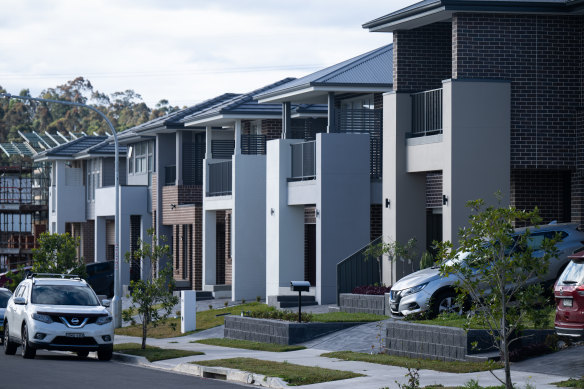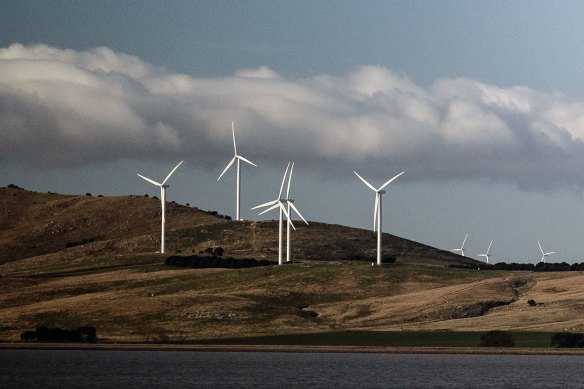This was published 8 months ago
Future Fund told to sink cash into homes and green energy
By Shane Wright
The nation’s $230 billion Future Fund will sink taxpayers’ money into building residential housing, renewable energy projects and cybersecurity infrastructure under the first major overhaul to its investment mandate since it was established.
The sovereign wealth fund, created in 2006 by then-treasurer Peter Costello to cover superannuation payments to public servants, will still have to make a commercial return, but it will have to consider investing in the government’s pet policy areas.

The Future Fund will be encouraged to invest in residential property companies, in line with the government’s own priorities.Credit: Louie Douvis
While Treasurer Jim Chalmers said the fund’s independence would not be affected by the government’s change to its investment mandate, the Coalition said it feared the move could funnel cash into failing Labor priorities.
The fund, which over the past 12 months made $24.4 billion, or 11.9 per cent, on its holdings, has operated under a broad mandate to deliver returns at least 4-5 per cent above the inflation rate.
Apart from not putting cash in areas that would breach international treaties signed by Australia – such as anti-personnel mines and nuclear weapons – or tobacco companies, the fund can invest in almost any area it believes will maximise its returns.
The new mandate will require it to “consider Australia’s national priorities in its investment decisions” where possible and consistent with its financial return remit.
Those priorities will be to increase the supply of residential housing, support the transition to net zero and improve domestic infrastructure that builds “economic resilience” amid concerns that a cyberattack or supply chain breakdown could disrupt the economy.
Chalmers, who installed former Rudd and Gillard government minister Greg Combet as Future Fund chairman this year, said he was committed to its independence and commercial focus.
But the change would mean where projects offered similar returns, the fund would favour investments that delivered on national priorities.
“Its primary objective will continue to be to maximise returns, the benchmark return rate will remain at between 4 and 5 per cent above CPI per annum over the long term, and there will be no change to the expected risk profile,” Chalmers said.
“The fund will provide the same strong returns to the government’s balance sheet while supporting national priorities where it can.
“This will mean more investment where we need it most, but not at the expense of returns.”
The fund already holds investments in various property, renewable energy and infrastructure companies. It has invested in Tilt Renewables, which has 1.8 gigawatts of wind, solar and battery storage projects and aims to have 7 gigawatts by the end of the decade, and has sunk money into Melbourne Airport’s planned $3 billion third runway.
Combet said meeting the 4-5 per cent plus inflation investment target remained the fund’s focus, but argued the priority areas aligned with the organisation’s own goals.
“The priority areas are aligned with the Future Fund’s thinking as set out in its position papers and consistent with its investment focus on seeking more local currency exposure and protection against sustained higher inflation,” he said.
The government has also committed not to draw down the fund’s holdings until at least 2032-33, by which time it is forecast to hold $380 billion in cash and assets.
Chalmers said the fund would be an “enduring” part of the economy, in effect confirming it would be permanent rather than being wound up when it had covered all outstanding superannuation liabilities.

Green energy projects such as wind farms may get investment from the Future Fund.Credit: Hilary Wardhaugh
Combet said this meant the Future Fund would be in place for years to come.
“With that certainty, we will be able to continue to invest for the long term, make sustainable contributions to the federal budget and continue to grow the value of the fund long into the future,” he said.
Opposition finance spokesperson Jane Hume said while the Coalition had yet to see the full details of the proposal, it would be worried by any changes that affected the fund’s independence.
“The Albanese government must not undermine the Future Fund’s independence by seeking to direct where and how it can invest simply to cover up its policy failures,” she said.
“It would do [Finance Minister] Katy Gallagher and Jim Chalmers well to remember that the Future Fund is a sovereign asset that belongs to all Australians, it is not a piggy bank for Labor to crack open when it can’t deliver on its priorities.”
Then-fund chairman Costello last year argued that the Future Fund should focus on making returns rather than pursuing social goals.
Neither Labor nor the Coalition had attempted to tell the Future Fund what to invest in, he said, and if this were to occur, it would “come to a very bad end”.
“This is an investment fund – we invest for return. That’s what we’re here for,” he said last February.
Apart from its core fund, the Future Fund also oversees six investment vehicles, including the $23.3 billion Medical Research Future Fund and the $10.6 billion Housing Australia Future Fund.
Cut through the noise of federal politics with news, views and expert analysis. Subscribers can sign up to our weekly Inside Politics newsletter.